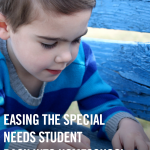
Most kids thrive with the more relaxed, open-ended rhythm of the holiday. But transitioning back into the regular school routine can be a challenge for anyone, let alone children with special needs, learning disabilities, or behavioral challenges. Anxious homeschooling moms circle their Back to School Day in red pencil in their minds, gritting their teeth and bracing for the worst as the date approaches.
Change, and More Change
It's human nature to balk at a return to
- expectations
- intense concentration
- less free time
Who among us relishes diving in to real life after the end of a restful vacation?
The problem is the disruption on top of a disruption many children with special needs feel at the end of a break. While days without math and science were novel and fun, they were still a disruption of the understood routine of life. Since most holiday respites don’t actually last long enough or contain enough predictable rhythm to establish a new routine for a child, going back to the original plan doesn't feel like a return to normalcy. Instead, it’s yet another change: a second shift on top of the first. The cumulative effect is a huge drain on a child’s coping skills.
Never Pick A Monday
Knowing this burden of change helps moms develop a re-entry battle plan for their students with special needs. One trick I’ve learned over the years is to take a cue from my local school district: never start your normal schedule back on a Monday if you can help it.
The short week that comes with selecting a Wednesday or Thursday allows a burst of the old school routine… and then a quick visit back to the relaxed days of being able to choose whatever diversion you wish.
Go Gradual
Another valuable tip is to not dive back into a full schedule all at once. Cherry pick a few favorite or more-easily understood subjects for the first few days. This method allows the child’s sensory system to settle back being focused on school work without the added challenge of taxing academics too.
Save the Hard Restart
It’s tempting feel the tingle of a fresh start in January and decide to mix up your homeschool. If you have a child with special needs, this is not the time for changes. Don't:
- try out a new math program
- introduce cursive out of the blue
- establish a completely new morning rhythm
Again, your child’s neurological and sensory systems are working overtime to compensate for what feels to them like an abrupt aboutface. Let the dust settle before you bring in the New Order!
If, even after carefully wading back in to school routines, you find that your child is more resistant than usual, vocalizing complaints, having difficulty staying on task, or otherwise is off, consider maintaining a bit of routine over the future breaks. Many children—even those considered neurotypical—have an easier time over extended breaks if they keep one foot in the homeschooling world.
Go to SmoothCourse to explore your options for a homeschool curriculum that's built on routine but with plenty of room to flex.








